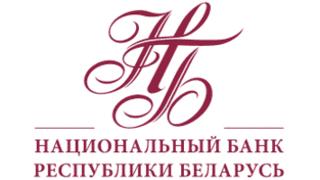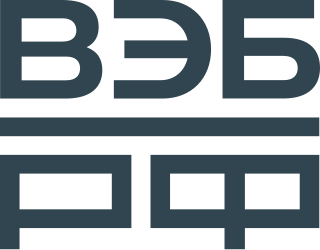
PJSC Sberbank is a Russian majority state-owned banking and financial services company headquartered in Moscow. It was called Sberbank of Russia until 2015. Sberbank has operations in several European nations, primarily post-Soviet countries.

The Central Bank of the Russian Federation, doing business as the Bank of Russia, is the central bank of the Russian Federation. The bank was established on July 13, 1990. The predecessor of the bank can be traced back to the State Bank of the Russian Empire founded in 1860.

Gosbank was the central bank of the Soviet Union from 1922 to 1991 within the country's single-tier banking system. After an extended gap in 1920-1921, it took over the legacy of the State Bank of the Russian Empire. It was eventually terminated on 1 March 1992 following the dissolution of the Soviet Union, and its operations were taken over by the central banks of the successor countries, including the Central Bank of Russia, National Bank of Ukraine, National Bank of Kazakhstan, and others.

Viktor Vladimirovich Gerashchenko, nicknamed Gerakl, was the chairman of the Soviet State bank and the Russian Central Bank during much of the Perestroika and post-Perestroika periods.

Uralsib is a Russian commercial bank, headquartered in Moscow. According to Russian Forbes, as of 2022, it was one of the country's largest banks with the net asset value of approximately 530 billion rubles.

The National Bank of the Republic of Belarus is the central bank of Belarus, located in Minsk. The bank was created in 1922 under the name of "Belarusian Republican Bank" by the Soviet of People's Commissars of Byelorussia, but soon worked under the direction of the State Bank of the USSR. Undergoing reorganizations in 1959 and 1987, the bank appeared in its current form in 1990 after the passage of banking rules upon declaring independence from the Soviet Union.

VEB.RF, or VEB, is a Russian state development corporation and investment company. It was founded in 2007 as a development institute. It has financed more than 300 projects.

Prominvestbank (full name - Joint Stock Commercial Industrial & Investment Bank is a bank based in Ukraine that was formed in August 1992. Its overall history goes back more than 86 years.
Moscow Narodny Bank is a Russian bank. It was established under the Articles of Association approved by the Ministry of Finance on March 3, 1911. It was opened in Moscow on May 9, 1912.

Moscow Narodny Bank Limited (MNB), London was created as an independent bank in October 1919 on the basis of the London branch or Mosnarbank (London) of the Moscow Narodny Bank, which had operated in London since 1915.

The Ministry of Finance of the Russian Soviet Federative Socialist Republic, known prior to 1946 as the People's Commissariat for Finance, or shortened to Narkomfin, was part of the government of the Russian Soviet Federative Socialist Republic from 1918 until the fall of the USSR in 1991. It was subordinate to the Ministry of Finance of the USSR.
Joint-Stock Commercial Bank of Turkmenistan Halkbank, is a Turkmen state-owned bank and financial services company, headquartered in Ashgabat. A network of Halkbank offices covers the whole territory of Turkmenistan, providing a wide range of services to the public.
Sergey Sergeevich Rodionov is a Russian publisher and banker. He was the founder, co-owner and CEO of Rodionov Publishing House until 2004. He was also the deputy chairman of the Central Bank of Russia in 1991. First wife- Svetlana Loschatova, chairman of Slaviansky bank, Moscow. Second wife- Olga Rodionova.
Rossiysky Kredit was a Russian commercial bank that ceased operations on 24 July 2015, when the Central Bank of Russia withdrew the bank's license.
Dmitri Alekseevich Lebedev is a Russian financier.
Auto Finance Bank, previously RN Bank, is a Russian bank that provides car loans and is owned by the Russian car manufacturer AvtoVAZ for financing its car sales.

East-West United Bank is a bank based in Luxembourg, established on 12 June 1974 by the Gosbank, the Soviet Union's central bank. It has been fully owned by Russia-based Sistema since 2018. The bank offered private banking and corporate financing. Since the Russian invasion of Ukraine in February 2022 the bank has had to surmount many problems. Unable to sell the business, Sistema took the decision in late 2023 to close the bank.

Rostovsocbank was a Russian commercial bank. It was established in 1989 and registered by the Central Bank of Russia in October 1990. The first commercial bank in the south of Russia was founded as a result of the commercialisation of the Rostov office of the USSR Zhilsocbank. In the 1990s, it used to be a major bank in the Rostov region with several branches in Rostov-on-Don and other cities such as Taganrog, Shakhty, Gukovo, and Donetsk.

Donskoy Narodny Bank was a Russian commercial bank. It was founded in 1992 as the Stanichny (Village) Commercial Bank (SCB) "Yegorlyk". Until 1998, it carried out its activities on the territory of Yegorlyksky District in Rostov Oblast. At the end of 1998, SCB “Yegorlyk” experienced financial difficulties and practically ceased operations. And after that, the Bank was acquired by new owners, among whom were the former employees and clients of the Gukovo branch of Rostovsocbank, which made a full refund to all clients and depositors in early 1998, despite the insolvency of the Rostovsocbank’s head office.
A single-tier banking system is a policy framework under which all credit institutions coexist without distinction about the quality of their liabilities, or in other words, there is no distinction between central bank money and broad money. This setting is generally associated with communist economic systems.













